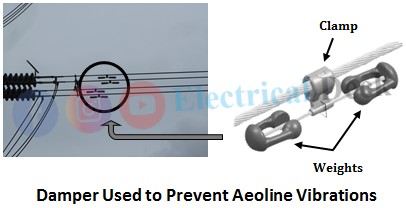The overhead transmission lines experience swinging in wind in the vertical plane. In addition to this, the overhead transmission line experiences two types of vibration. They are,
- Aeoline vibrations
- Galloping or Dancing vibrations
Aeoline Vibrations :
Aeoline vibrations are also known as resonant vibrations or high-frequency vibrations. The winds that are moving at speed of 5-20 km/hr with vortex phenomena (i.e., spiral movement and attracts things at the center) results in the aeoline vibration of the line conductor.
The vibration is in the form of a sinusoidal loop across the span whose magnitude is in the range of 20 to 50 mm with high frequency (i.e., 50 to 100 Hz) which may result in the breakdown of conductors from supports and clamps. The length and frequency of the vibration loop is given by the formula,
Length L = 1/2f √(T/W)Where,- T = Tension on conductor
- W = Weight of the conductor
- f = Frequency
Frequency is given by,f = 50(V/d)- V = Wind velocity
- d = Diameter of conductor
Method to Damp Out Aeoline Vibrations :
Aeoline vibrations are not so harmful but may cause troubles at points where vibrations are restricted. In order to avoid these problems dampers are used. The main function of the damper is to absorb the vibrational energy and prevent vibrations.
One of the special types of damper used to prevent aeoline vibrations is the stock-bridge damper. The below shows the stock-bridge damper on the transmission line to damp out aeoline vibrations
It consists of a stranded cable 0.3 to 0.50 m long to which two hollow weights are attached at either end which is clamped to the line conductor. The weights are made up of galvanized iron. The clamp is attached to the conductor using one bolt.
This type of arrangement is most effective and the damper may be attached to the line conductor even when the line is carrying current. In this type of damper, the vibrations are damped out by dissipating the vibrational energy of the conductor by hysteresis and inter-strand friction in the stranded cable.
Galloping or Dancing Vibrations :
These are low frequency and high amplitude vibrations. The frequency is about one hertz and the amplitude is about 6 meters. These vibrations are the self-excited type i.e. once they start they continue to build within themselves and become very large. The main cause of these vibrations is the irregular coating of sleet.
Due to this, the conductor vibrates horizontally and vertically with large amplitude in an irregular manner in two or more loops. Sometimes the two loops appear superimposed on one loop. This will lead to contact between phases or between the phase conductor and ground wire and also mechanical damage at the supports. The worst effect of galloping may be a flashover between two phases.
Method to Damp Out Galloping Vibrations :
Vibrations due to galloping can be damped out by making circular conductors. In the case of stranded conductors, PVC cable is wrapped to make them circular. However, this method is employed when there is no sleet formation. The sleet coating over the conductors can be reduced by dissipating heat energy as I2R losses.

